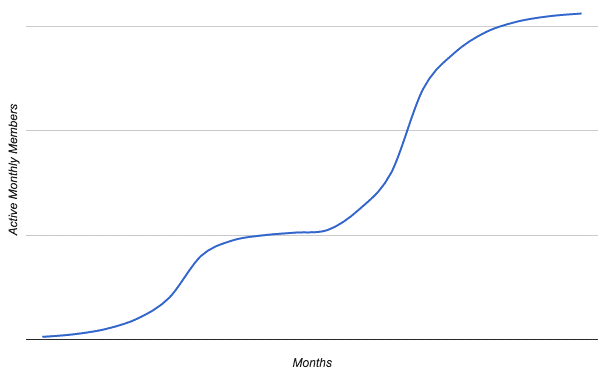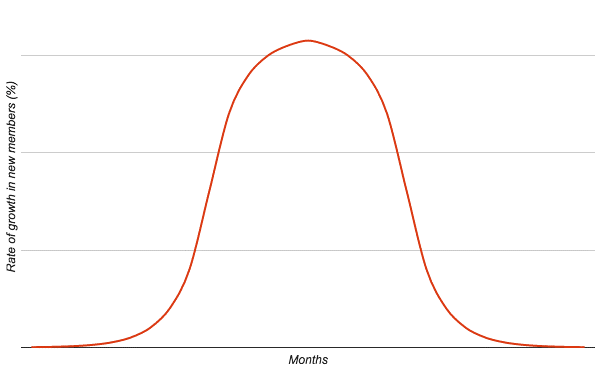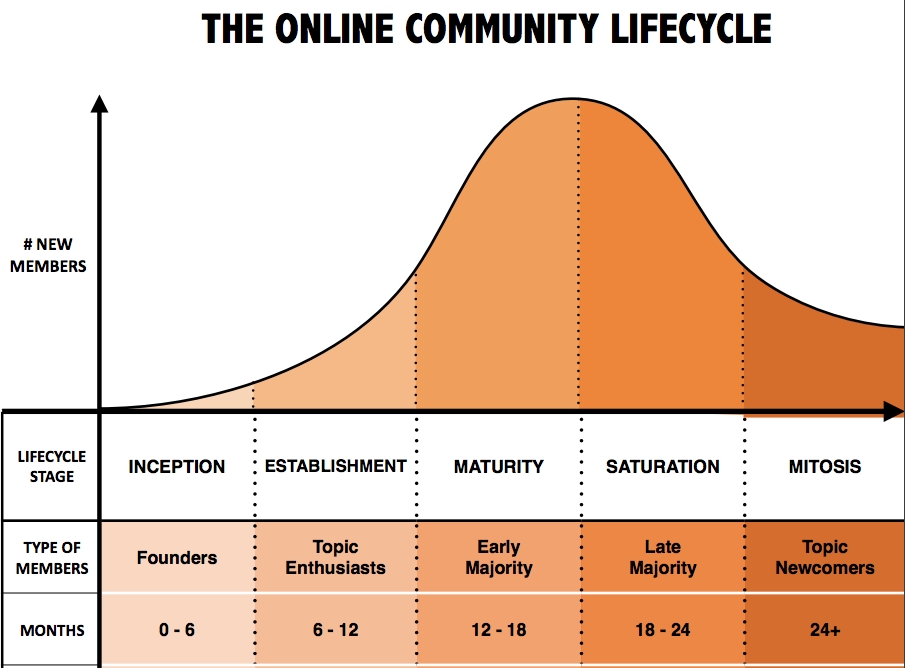There is a lot of superstition behind community growth.
This superstition often leads to the doomed big bang approach or the equally unsuccessfully big promotional push (competitions, challenges, giveaways) to save struggling communities.
If you understand the science behind community growth, you will know why both efforts are always doomed to fail.
Better yet, you will know how to check your community is growing at the right speed and increase your growth rate.
By the end of this post, you should be able to change your approach to increase the speed of growth (and dazzle your boss with your scientific expertise).
How Fast Should Your Community Be Growing Right Now?
If you’ve created a highly transmissive community concept, have a focused target audience with dense connections with other members, and you’re keeping your members active when they join, the graph showing your number of active members should look like this.
Health Community Growth

This chart essentially shows that you begin with a small handful of members, see a sudden rise in active members as word spreads, before plateauing in the maturity phase.
This is the ultimate healthy growth chart for any online community.
You want your growth rate to as closely resemble the chart above as possible (we’ll explain why soon). Unfortunately, most communities don’t resemble this at all. Most communities resemble one of the four graphs below:

Check your active membership levels are healthy
The first check to see if your growth rate is healthy is to export the number of daily active members (or returning visitors if you need a proxy) and create a graph (used curve lines / trendlines) to see what your growth looks like.
This also gives you a very good indication of future growth potential as well. If things used to grow quickly and are now levelling off, it’s fair to say you’ve reaching peak potential.
Of course, if you revamp your focus (say, begin targeting SEO professionals and expand to inbound marketing professionals) your graph might more resemble an horizontal S shape below.

And this is the secret to communities that escape beyond their initial confines. They don’t perform some remarkable marketing tactic, they expand their focus to accommodate more members (while cleverly not losing their existing members).
Here’s a simple task. Export the number of active members since the community launched and create a chart showing this level of community growth.
If you can’t access this data, then use returning visitors from Google Analytics.
To make sense of this you might need to add a trendline as shown below.

Data from a former client above follows (despite a recent spike, we improved their platform), the path of healthy community growth (almost) perfectly.
The community grew to a level where the number of monthly active member is beginning to plateau. This is as big as the community is likely to get without a big change in focus.
And this is the part that might save your job one day. If you’re managing a mature online community (let’s say one that’s been around for 5+ years) and the number of active members is holding steady, don’t ever agree to increase this figure. Increasing the number of active members in a mature community can be a difficult (possibly impossible) task.
To understand why, we need to understand the bell curve and the rate of growth.
The Bell Curve, The Rate Of Growth, And The Spread of Diseases
The rate of growth is how many members you attract compared with the previous month.
If you attracted 200 members this month compared with 150 last month, your rate of growth is 50.
If next month you attract 230 new members your rate of growth has dropped to 30 (even though your absolute growth has increased).
Most communities have a zero rate of growth.
This means they’re still attracting new members but it’s almost exactly the same number of new members each month. It might be 30 this month, 30 the month before, and 30 the month before that. For mature communities, this is fine. For everyone else, this isn’t so good. This number should be steadily rising.
The ideal community resembles a bell curve below.

The rate of growth should (in perfect conditions) follow the bell curve above. It begins at 0, rises slowly at first until it hits the critical mass point. Then it rises rapidly until peak growth has been achieved before falling back down to 0.
Here’s the important thing to remember here.
The long-term rate of growth for all communities will always return to 0 on a long-enough time scale.
This doesn’t mean they stop growing, but they stop growing at any increased speed.
You see this bell curve in many places. Google Trends isn’t the best proxy, but you can see similar curves in many popular communities:
Product Hunt, for example, has probably just passed the peak of its bell curve. .
It’s probably still growing, but not as fast as it used to.
Mumsnet too is probably on the other side of the bell curve for now.
Facebook also fits the mold particularly well.Reddit, perhaps surprisingly, probably hasn’t yet (I suspect we’ll see a sudden flashover point soon).
Sometimes these are less easy to predict. Instagram might be near it’s peak while Snapchat is about to be close to the flashover point.
(note, if you’re reading this post months/years later after publication, these graphs might look very different. Let me know how our predictions did).
The Basic Reproduction Number And The Bell Curve
Your bell curve will follow your basic reproduction number.
The basic reproduction number is a term network scientists have borrowed from epidemiologists (people that measure the spread of diseases). It simply means the number of additional cases (infections) each individual case generates.
The higher the number, the faster the spread of the disease. Your rate of growth is dictated by your basic reproduction number.
In our context, this means the number of active members each additional active member generates.
How might an active member bring in a newcomer? There are four main channels:
1) Members might create content that is found via search engines and brings in more traffic whom become members.
2) Members might share content on social channels and bring in others.
3) Members might mention the community to their friends offline.
4) Members might write about the community on their own sites which have significant traffic (this also increases search rankings).
(p.s. The more you can encourage members to do the following, the faster you grow).
Your basic reproduction number is influenced by:
1) Contacts. This is the number of contacts made between your regular members and the susceptible population (the no. people interested in this topic).
The easiest way to calculate this is to track mentions of your community URL and estimate the reach of those mentions (twitter is easy, web traffic/Facebook is more difficult). There will be a big overlap here (many susceptible members follow the same people on Twitter, for example). Some tools let you estimate this overlap (hootsuite, brandwatch insights), others might not.
2) Probability of transmission. This is the likelihood of each contact ‘transmitting’ the community to someone else (i.e. someone joining the community as a result of that contact). Highly transmissive communities have a powerful, relevant, community concept and excellent UX / calls to action that invite a newcomer to join and participate.
You can measure this by dividing the number of new registrations each month by the number of external mentions of your community. If your combined reach of mentions is 200,000 people and you have 100 new members, your transmission rate in each contact is 0.05% (this is the most simplistic method, it overlooks the overlap mentioned above).
3) Duration of active membership*. This is the length of time someone remains active in the community compared with that time period. The longer someone remains actively sharing community content, the higher your reproductive number. If you’re churning through members, your reproductive rate is lower. This is calculated by average length of actively talking about the community for that same time period (for example, 30 days would be 1. 15 days would be 0.5).
Your basic reproductive number is the contacts * probability of infection * duration of infection.
If each additional member doesn’t bring in at least 1 new member (directly or indirectly) your community will enter a death spiral.
This is the really critical lesson here.
If your basic reproduction number is below 1 (i.e. if you’re not getting at least 1 additional new member for each member you bring in, no marketing tactic on earth can save you). All that time and money you spend promoting the community is inevitably wasted.
Explaining The Bell Curve
This also explains why growth begins slowly, suddenly rises, and then falls almost as fast (the bell curve).
In the beginning, you have a small number of ‘infected’ members and a large number of ‘susceptible’ members. The probability of being ‘infected’ with the community concept is small but rises exponentially with each additional member that joins.
If you meet two infected people, for example, you have twice the probability of contracting their disease. This will grow slowly at first before reaching a sudden flashover point (or tipping point) where the probability is rising so quickly due to infinitely more people becoming infected. The probability of transmission isn’t change, just the number of infected members.
This rises until you reach the peak growth, after which your rate of growth declines because you begin to run out of susceptible people to ‘infect’. Everyone already likely to join the community already has.
So why doesn’t the number of new registrations eventually fall to zero?
Because there are always new people becoming interested in the topic. In mature communities your long-term rate of growth will closely mirror the number of newcomers becoming interested in the topic for the first time. If this number rises, the community rate of growth might rise again for a period. If it falls, your growth rate falls too.
This is also why new communities should focus on people with plenty of experience in the topic while mature communities need to better cater to newcomers.
The Bell Curve And The Online Community Lifecycle
We use the bell curve of new registrations in our online community lifecycle too.

Again you see how the number of new members rises as you progress through the lifecycle before eventually falling to a more sustainable rate based upon newcomers to the topic.
What Actions Do I Need To Take To Improve My Rate Of Growth?
Everything we’ve covered before gives us some scientifically valid ways of growing our online communities.
1) Measure your current number of new members (or clicks on your registration page). Is this speeding up, slowing down, or holding steady? Compare it to the charts above to see if they are healthy.
2) Increase the number of contacts between members and interested non-members. You can increase this by making it easier to share content (prompting people, including sharing options, providing invites members can use, integrating their social accounts etc…). You can also increase motivation to share (involving members in the creation of content, improving the quality of content, creating really useful material to share that helps newcomers, doing remarkable things). You might create a social norm that it’s expected to talk about the community.
3) Increase the size of the susceptible audience. If you’ve hit maturity, most members are in competitor communities, or you’ve already churned through most people, you need to expand the audience you’re targeting. You can change the topic focus to attract newcomers, focus on newcomers to the topic or deliberately make the jump across a barrier to a new group (e.g. different languages/locations).
4) Create a more transmissive concept. By far the most powerful way to increase growth is to make your community more transmissive. Some communities explode to life because the concept (the very idea) of the community is so relevant and exciting. Change the name, unique focus, type and purpose of the community. This is the most cost-effective improvement you can ever make.
5) Keep regular members active for longer. If you can increase the retention rate of your members (you measure this right?), you can increase the amount of time someone in your community might transmit the community to others. This is going to mean increasing their sense of competence, relatedness, and autonomy within the community.
You’re probably thinking “but I’ve already tried to do that and it isn’t working!”
Believe me, if this isn’t working then neither will any typical marketing tactic.
Marketing tactics accelerate the speed at which a community with a >1 reproductive number spread, but won’t save one with a reproductive number
You get a short spike in activity followed by a longer decline.
Speaking from personal experience, the best way to improve your community is to improve the concept. Everything else tends to stem from how transmissive the concept of the community is. Sadly this is also the thing we most quickly overlook.
Summary
Don’t compare the growth of your community against another, especially a mature community. A mature community with thousands of members, millions of inbound links, a hard-earned high search ranking/reputation will attract more members than your fledgling effort.
What’s more important than absolute growth is the rate of growth. Is this rising or falling? Does this match where you are on the lifecycle. Don’t ever try to promote a community until you’ve managed to get a reproductive rate >1 . Throwing more members at a failing community simply delays the inevitably agony.
Measure and track your growth rate against the examples above. Slowly increase the growth rate by making it easier to share community activity, expanding the susceptible audience of the community, creating a more transmissive concept, and keeping your regular members active for longer.
This sounds more complicated than it is. The key message is to forget promoting your way out of your problems. Instead go deeper and increase your reproduction number. Everything else improves from there.
*technically this is the length of time a member stays actively promoting the community, but this is almost impossible to track


 NASAJuno
NASAJuno Samsung today sent out invites for its next Unpacked event that will be held on August 2nd. The company has already confirmed in its announcement that it will be launching the Galaxy Note 7 at the event.
Samsung today sent out invites for its next Unpacked event that will be held on August 2nd. The company has already confirmed in its announcement that it will be launching the Galaxy Note 7 at the event.
























